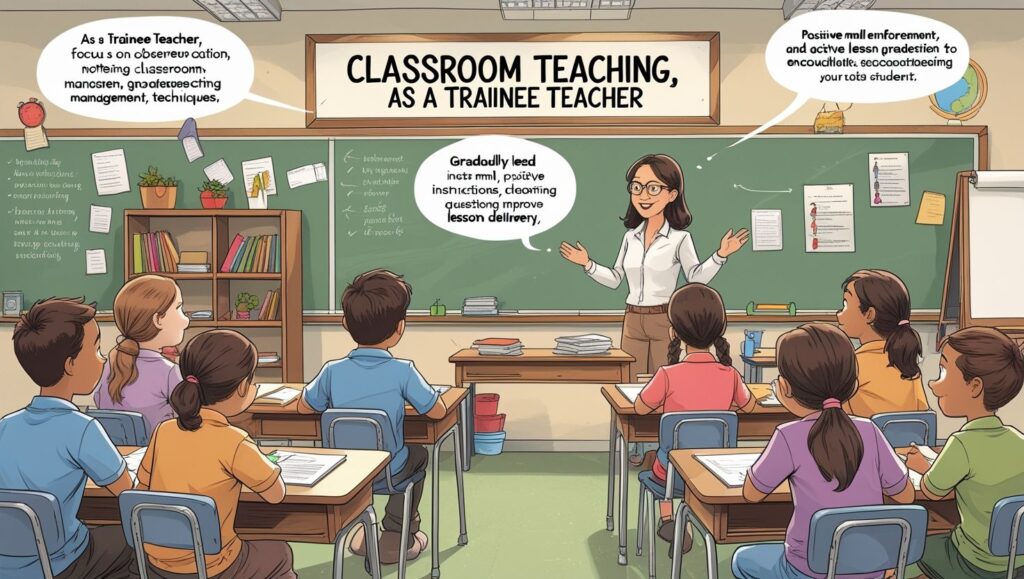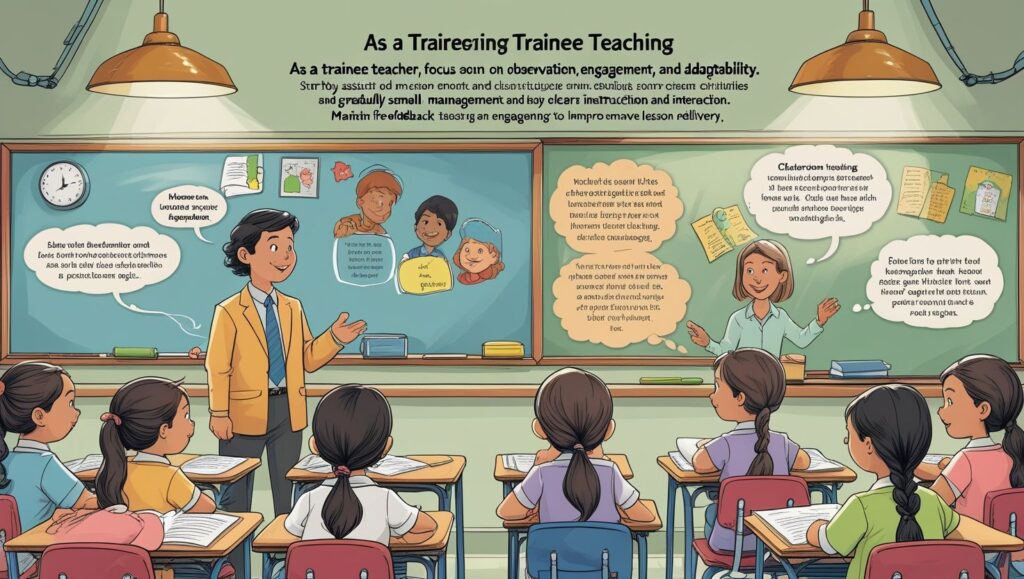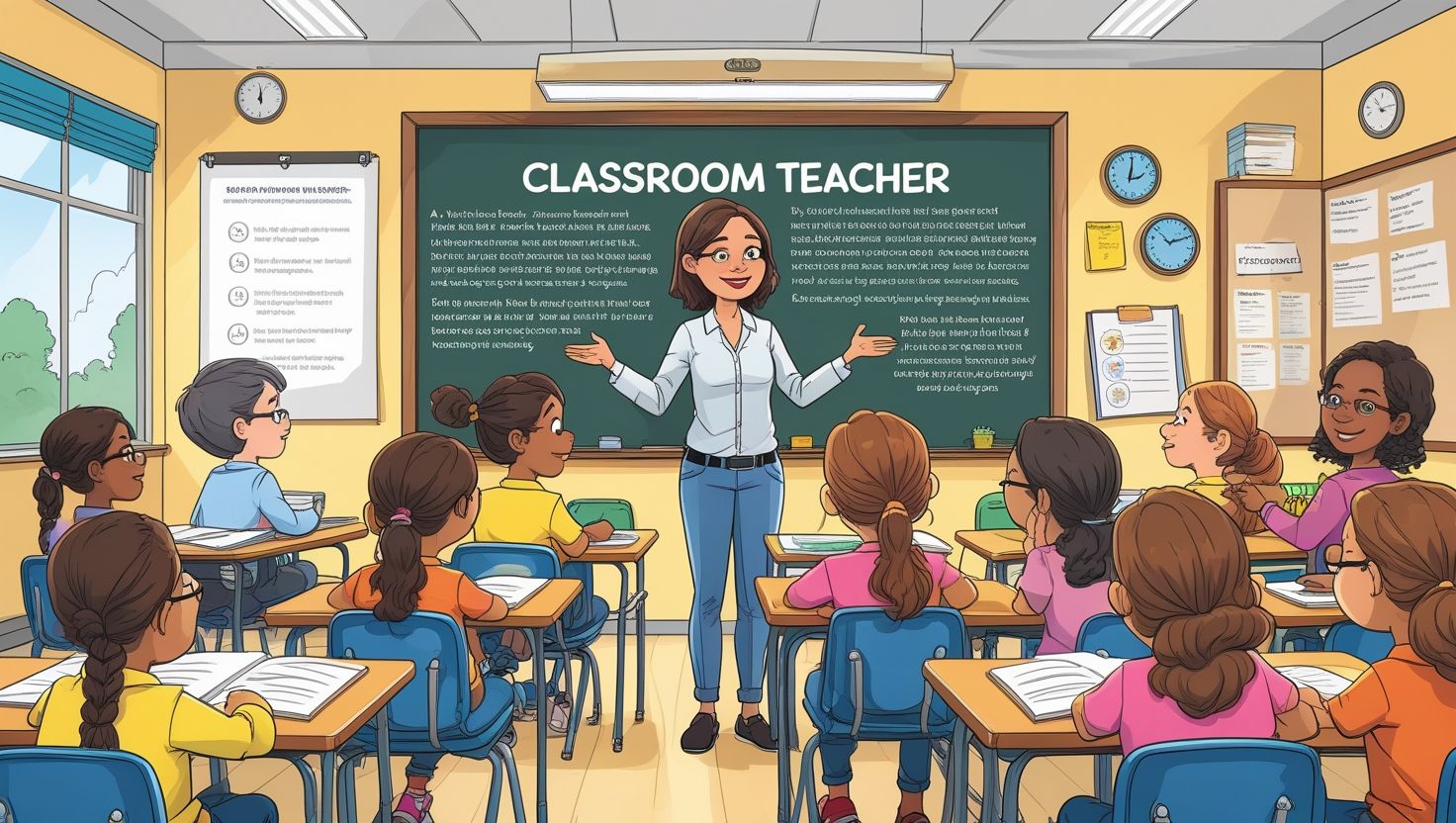1. Introduction
Classroom Teaching as a Trainee Teacher, Classroom teaching is the cornerstone of every teacher’s professional journey. For a trainee teacher, it marks the transition from theoretical understanding to real-world application. During teacher training programs, individuals acquire vast knowledge in pedagogy, curriculum design, and child psychology, but it is within the classroom that this knowledge is tested. Teaching as a trainee offers both a learning experience and a proving ground where skills are honed through practice.
This period is critical because it enables the trainee to adapt teaching styles to diverse learners, manage a live classroom, and gain feedback from mentor teachers. Moreover, it presents an opportunity to understand school culture, collaborate with staff, and participate in co-curricular activities. As trainee teachers immerse themselves in planning lessons, delivering content, and managing behavior, they begin to develop their teaching identity. This foundational phase is crucial in shaping confident, competent, and reflective educators who can meet the dynamic demands of modern classrooms.
2. Planning and Preparation for Teaching Practice
Planning is a vital part of successful classroom teaching, especially for trainee teachers. Before stepping into a classroom, the trainee must invest time in developing comprehensive lesson plans that align with learning outcomes. Planning involves identifying the subject matter, selecting suitable teaching methods, designing activities, and preparing necessary instructional materials. It also requires consideration of student diversity, including varied learning styles and abilities. Effective preparation builds confidence and helps maintain classroom flow. Trainees often collaborate with their mentor teachers to understand school-specific curricula and expectations.
Additionally, they familiarize themselves with assessment tools and standards. Planning also includes preparing questions to check understanding, assigning homework, and anticipating possible challenges. Pre-class preparation reduces anxiety and enables the trainee to focus more on student engagement during instruction. It cultivates professionalism and demonstrates commitment to the teaching role. In essence, planning and preparation form the backbone of successful classroom experiences and establish a solid foundation for long-term teaching effectiveness.

3. Understanding Classroom Environment and Dynamics
For trainee teachers, understanding the classroom environment is crucial to effective teaching. A classroom is not just a physical space but a dynamic learning environment shaped by student behavior, interpersonal relationships, and social interactions. As newcomers, trainee teachers must observe and learn how students communicate, collaborate, and respond to authority. This helps them tailor their approach for better engagement. Classroom dynamics include recognizing peer groups, leadership roles among students, and varying attention spans.
A trainee should also be aware of the seating arrangement, accessibility, classroom resources, and time management practices. By adapting to this environment, the teacher-in-training can foster a positive and inclusive learning atmosphere. Respecting the culture of the classroom while introducing new strategies is a balancing act that develops over time. Being sensitive to the emotions and energy levels in the room enables the trainee to manage disruptions and maintain order effectively. Ultimately, understanding classroom dynamics leads to better communication, increased student participation, and a productive learning experience.
4. Effective Teaching Strategies for Trainee Teachers
Trainee teachers must be equipped with a variety of teaching strategies to accommodate the diverse needs of learners. Effective teaching strategies include direct instruction, cooperative learning, questioning techniques, storytelling, and interactive activities like role-playing and group discussions. The choice of strategy depends on the learning objectives, subject matter, and student readiness. During their practicum, trainees experiment with multiple approaches to determine which work best in specific situations.
They also learn how to differentiate instruction by adjusting content, process, and product to cater to varied learning abilities. Use of multimedia tools and educational technology can enhance engagement and clarify difficult concepts. Another important strategy is scaffolding, where the teacher provides temporary support that gradually decreases as the learner gains independence. Active learning, which encourages participation, critical thinking, and reflection, is also highly effective. Through constant feedback and observation, trainee teachers refine these strategies, learn to adjust in real-time, and build a toolkit of methods that make their teaching more effective and inclusive.
5. Classroom Management and Discipline
Classroom management is a vital skill that trainee teachers must develop to ensure a conducive learning environment. It involves establishing rules, setting expectations, managing time, and handling student behavior. Effective management promotes respect, focus, and collaboration among students. For trainee teachers, this can be one of the most challenging areas, as they learn to command authority while still developing their teacher identity. They must strike a balance between being approachable and maintaining discipline. Setting clear routines at the beginning of the lesson, using positive reinforcement, and consistently applying consequences for misbehavior are essential techniques. Trainees should also learn non-verbal cues, such as gestures or proximity control, to manage distractions discreetly. Understanding individual student needs and triggers for disruptive behavior helps in implementing proactive interventions. Mentor teachers often provide guidance on managing difficult scenarios. Mastering classroom management enhances the effectiveness of instruction and ensures that all students feel safe and respected, contributing to a positive and productive classroom culture.
6. Assessment and Evaluation Skills
Assessment is an integral part of teaching, and trainee teachers must become proficient in evaluating student learning. It can be formative, summative, diagnostic, or performance-based, depending on the learning objectives. As part of their teaching practice, trainees are expected to design quizzes, assignments, presentations, and other tools to assess student understanding. They must also learn how to analyze assessment data to inform instruction. Rubrics, checklists, and observation sheets are useful tools for maintaining consistency in grading.
Giving constructive feedback is another essential skill. Trainee teachers should aim to provide timely, specific, and actionable feedback that helps students improve. Self-assessment and peer-assessment activities can also be introduced to encourage reflection and responsibility among learners. Beyond academic performance, assessment of skills such as teamwork, communication, and creativity is important. Learning how to adapt assessments for students with different needs or language barriers is also critical. Through practice, trainee teachers enhance their ability to measure learning outcomes effectively and support student growth.

7. Communication with Students and Staff
Effective communication is the foundation of successful classroom teaching. Trainee teachers must develop strong verbal and non-verbal communication skills to convey information clearly and build rapport with students. Clear instructions, tone modulation, eye contact, and body language all play a role in classroom interactions. Listening is equally important; it shows respect and allows teachers to respond appropriately to students’ needs and concerns. Trainees must also learn how to communicate with other staff members, including mentor teachers, administrative personnel, and support staff.
Professional communication includes participating in meetings, collaborating on lesson planning, and seeking feedback. Understanding school protocols and reporting procedures is also part of effective staff communication. In addition, engaging with parents through meetings, emails, or student reports helps in building a support system for the learners. Strong communication fosters a positive classroom culture, reduces misunderstandings, and promotes a collaborative learning environment. As trainee teachers grow, their ability to communicate with empathy, clarity, and confidence enhances their effectiveness as educators.
8. Reflection and Self-Evaluation
Reflection is a critical component of professional growth for trainee teachers. It involves analyzing one’s teaching practices, identifying strengths, and recognizing areas for improvement. After each lesson or school day, trainees are encouraged to journal their experiences—what went well, what challenges arose, and how they can improve in the future. This habit promotes self-awareness and continuous improvement. Self-evaluation includes assessing lesson plans, student engagement, classroom management, and communication skills.
It often involves comparing intended learning outcomes with actual student performance. Constructive criticism from mentor teachers and peers is also a valuable source of insight. Reflection can also be guided using teaching standards and evaluation frameworks. Over time, trainee teachers begin to make more informed decisions, experiment with new strategies, and adapt quickly to different situations. Developing a reflective mindset is essential in nurturing lifelong learning and professional excellence. It turns everyday teaching experiences into opportunities for meaningful growth and enhances overall teaching effectiveness.
9. Role of Mentors and Supervisors
Mentors and supervisors play a crucial role in shaping the trainee teacher’s professional journey. These experienced educators offer guidance, support, and constructive feedback throughout the practicum period. Mentors often serve as role models, demonstrating effective teaching practices, classroom management, and student engagement techniques. They help trainees navigate the complexities of school culture, curriculum standards, and classroom expectations. Supervisors, often from the teacher training institution, observe lessons, evaluate performance, and ensure that educational goals are being met. Regular meetings with mentors and supervisors provide an opportunity for reflection and dialogue.
Trainee teachers benefit from their advice on lesson planning, handling diverse learners, and resolving classroom challenges. The feedback loop established with mentors and supervisors accelerates professional development and builds confidence. A strong mentoring relationship fosters a safe environment for asking questions, exploring ideas, and learning from mistakes. Ultimately, the support of mentors and supervisors is instrumental in transforming trainee teachers into skilled, reflective, and effective professionals.
10. Challenges Faced During Teaching Practice
Trainee teachers often face several challenges during their classroom teaching practice. One common issue is managing classroom behavior, especially with unfamiliar students. Establishing authority while building rapport can be difficult for novices. Time management—completing lessons within the allocated period—also presents a learning curve. Trainees may struggle with lesson pacing, transitioning between activities, or engaging slow learners. Designing differentiated instruction to meet varied student needs is another complex task.
Additionally, balancing workload, preparing teaching materials, and coping with performance pressure can cause stress. Language barriers, cultural differences, or limited resources may further hinder the teaching process. Sometimes, criticism from mentors or classroom disruptions can dent self-confidence. However, these challenges are essential for growth. Overcoming them with the support of mentors, peers, and reflective practice fosters resilience and adaptability. Recognizing that challenges are a normal part of the learning process helps trainees approach their practice with patience and perseverance, ultimately turning obstacles into opportunities for professional and personal development.
11. Impact on Professional Development
Classroom teaching as a trainee teacher significantly impacts one’s professional development. It bridges the gap between theory and practice, allowing aspiring educators to apply pedagogical knowledge in real-time scenarios. Through this experience, trainees develop a deeper understanding of curriculum standards, student psychology, and instructional strategies. It enhances critical thinking, problem-solving, and decision-making skills. Exposure to real classroom situations builds confidence and prepares trainees for the unpredictable nature of teaching. Moreover, the practicum experience strengthens soft skills such as communication, collaboration, empathy, and adaptability—qualities essential for effective teaching.
Trainees also begin to develop their unique teaching style and philosophy, guided by observation, reflection, and feedback. Professional relationships with mentors, staff, and students contribute to networking and future career opportunities. Overall, teaching practice transforms theoretical learners into practical, student-centered educators. It lays the groundwork for continuous learning, certification, and career advancement. The skills, insights, and experiences gained during this period have a lasting impact on a teacher’s lifelong journey in education.
12. Conclusion:
Classroom teaching as a trainee is a transformative phase in a teacher’s journey. It provides real-world insights, cultivates essential skills, and fosters professional confidence. From lesson planning and classroom management to communication and reflection, each aspect of teaching practice contributes to shaping an effective educator. Despite the challenges, the practicum offers invaluable experiences that enrich both personal and professional growth. The support from mentors, supervisors, and peers helps in overcoming obstacles and refining teaching methods.
Most importantly, it nurtures a mindset of lifelong learning and dedication to student success. As trainee teachers evolve through hands-on practice, they begin to see education not just as a job but as a responsibility and a passion. The road to becoming a teacher is paved with effort, learning, and resilience—and classroom teaching as a trainee lays the foundation for a fulfilling and impactful career in education.

Bakırköy su tesisat kaçak tespiti Sarıyer su kaçağı tespiti: Sarıyer’de su kaçağı için en güvenilir ve hızlı çözümler burada. https://www.ayuujk.com/read-blog/10739
Beyoğlu su kaçağı tespiti Kozyatağı su kaçağı tespiti: Kozyatağı’nda su kaçağını hızlıca buluyoruz. https://followmylive.com/read-blog/84525
su kaçak tespiti hizmeti Kısa Sürede Tamir: Kaçak tespiti sonrasında tamir işlemi çok kısa sürdü. Şimdi tesisatımız sorunsuz çalışıyor. https://bluturr.com/read-blog/3135
Definitely believe that which you stated. Your favorite justification seemed to be on the web the simplest thing to be aware of.
I say to you, I definitely get irked while people think about worries that
they just don’t know about. You managed to hit the nail upon the
top as well as defined out the whole thing without having side-effects , people can take a signal.
Will likely be back to get more. Thanks
dcocvt
Saved as a favorite, I really like your blog!
Keep up the great work, I read few articles on this website and I conceive that your web blog is real interesting and has got lots of wonderful info .
Super-Duper website! I am loving it!! Will be back later to read some more. I am bookmarking your feeds also
I’m impressed, I must say. Really rarely do I encounter a weblog that’s both educative and entertaining, and let me let you know, you’ve hit the nail on the head. Your concept is outstanding; the issue is something that not sufficient persons are speaking intelligently about. I am very completely happy that I stumbled throughout this in my seek for one thing referring to this.
I like what you guys are up too. Such intelligent work and reporting! Keep up the excellent works guys I’ve incorporated you guys to my blogroll. I think it’ll improve the value of my web site 🙂
I’d incessantly want to be update on new blog posts on this website , bookmarked! .
Whats up are using WordPress for your blog platform? I’m new to the blog world but I’m trying to get started and create my own. Do you require any html coding knowledge to make your own blog? Any help would be greatly appreciated!
Some genuinely interesting information, well written and loosely user genial.
After looking into a number of the blog posts on your blog, I honestly like your way
of blogging. I saved as a fvorite it to my
bookmark website list and will be checking back soon. Please visit my website as well and telol me wwhat you think. https://yv6bg.mssg.me/
so much great info on here, : D.
Wohh just what I was searching for, regards for putting up.
Excellent blog here! Also your website loads up very fast! What host are you the use of? Can I get your associate link in your host? I want my web site loaded up as fast as yours lol
I simply wanted to develop a simple comment to be able to thank you for those fabulous guides you are posting on this site. My time-consuming internet search has at the end of the day been recognized with reputable knowledge to write about with my family and friends. I ‘d assert that most of us visitors actually are really blessed to dwell in a great site with very many awesome people with helpful tactics. I feel truly grateful to have encountered the website and look forward to some more brilliant times reading here. Thank you once more for a lot of things.
Thanx for the effort, keep up the good work Great work, I am going to start a small Blog Engine course work using your site I hope you enjoy blogging with the popular BlogEngine.net.Thethoughts you express are really awesome. Hope you will right some more posts.